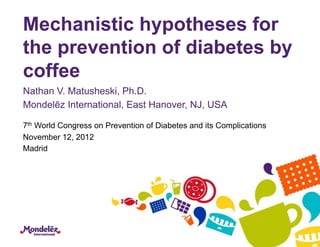
The coffee conundrum: Potential mechanisms for decreased diabetes risk
- 1. Mechanistic hypotheses for the prevention of diabetes by coffee Nathan V. Matusheski, Ph.D. Mondelēz International, East Hanover, NJ, USA 7th World Congress on Prevention of Diabetes and its Complications November 12, 2012 Madrid
- 2. The coffee conundrum: Coffee consumption has been associated with decreased diabetes risk – but why? What is the physiology? • Energy expenditure? • Glucose metabolism? • Insulin sensitivity? • Caloric displacement? What is the “food substance”? • A known bioactive? • An unidentified bioactive? • A nutrient? • Caffeine? • The absence of substance?
- 3. Let’s speculate together… • Which are the most biologically plausible mechanisms? • Where do we go from here?
- 4. Energy Expenditure Hypothesis Caffeine has been shown to increase energy expenditure Physiology: • Caffeine antagonizes the adenosine receptor1 • Increased cAMP concentrations are observed2 • Basal metabolic rate is transiently increased3 • Net increases of up to 150 kcal/day4 Experimental data: • High amounts (~600-1200 mg/day) are required • Coffee contains only about 100 mg caffeine per cup 1Nawrot et al. Food Additives and Contaminants 20, 1–30 (2003). 2Fisone et al. Cell. Mol. Life Sci. 61, 857–872 (2004). 3Acheson et al. Am. J. Clin. Nutr. 33, 989 (1980). 4Dulloo et al. Am J Clin Nutr 49, 44–50 (1989).
- 5. Carbohydrate Metabolism Hypotheses Glucose kinetics or glucose homeostasis may be acutely influenced by chlorogenic acid Physiology: 40.0# Incremental*Blood*Glucose*(mg/dL)* 35.0# • Chlorogenic acid (5-caffeoylquinic acid) 30.0# 25.0# may inhibit carbohydrate digestion or 20.0# glucose absorption1 15.0# 10.0# • Decreased hepatic glucose output 2 5.0# 0.0# • Modified incretin responses3 0# 20# 40# 60# 80# Time*(min.)* 100# 120# 140# Experimental data: • Mixed results from acute crossover studies4 • In vitro results suggest effective concentrations may be approached in the intestine but plasma concentrations are far lower 1Naritaand Inouye. J. Agric. Food Chem 57, 9218–9225 (2009). 2Bassoliet al. Cell Biochem. Funct 26, 320–328 (2008). 3Johnston et al. Am. J. Clin. Nutr 78, 728–733 (2003). 4Matusheski et al. Ch. 8 in Coffee: Emerging Health Effects and Disease Prevention. Wiley-Blackwell: 2012. pp. 161-163.
- 6. Insulin Sensitivity Hypotheses A sub-set of mechanisms has emerged that may explain an improvement in insulin sensitivity • Anti-inflammatory effects? • Anti-oxidative effects? • Hormonal effects, e.g. glucocorticoid? • Chelation of iron?
- 7. Insulin Sensitivity: Inflammation Coffee contains components that may modulate inflammatory pathways, leading to improved insulin sensitivity Physiology: • Caffeic acid phenethyl ester, diterpenes or 3-methyl-1,2-cyclopentanedione may regulate inflammatory pathways1,2,3 • Decreased inflammation (e.g. downregulation of NFκB) may improve insulin sensitivity4 Experimental data: • Some promising indications from clinical research5 • Limited epidemiologic associations 1Chung et al. J. Agric. Food Chem. 55, 6787–6792 (2007). 2Kim et al. Toxicol. Appl. Pharmacol 217, 332–341 (2006). 3Feng et al. J. Biol. Chem 280, 27888–27895 (2005). 4Goldfine et al. Clin. Chem. (2010). 5Kempf et al. AJCN 91, 950 –957 (2010).
- 8. Insulin Sensitivity: Mediation of Oxidative Stress Coffee contains components that may modulate redox pathways, leading to improved insulin sensitivity Physiology: • Chlorogenic acid and/or N-methylpyridinium may regulate redox pathways leading to activation of ARE/XRE-mediated responses1 • Mediation of oxidative stress may positively impact insulin resistance or complications of diabetes2 Experimental data: • Mainly pre-clinical and in vitro research • Reduction in 8-isoprostanes in one clinical intervantion3 1Boettler et al. J. Nutr. Biochem 22, 426–440 (2011). 2Liet al. Exp Diabetes Res 2012, 216512 (2012). 3Kempf et al. AJCN 91, 950 –957 (2010).
- 9. Insulin Sensitivity: Hormonal Coffee contains components that may interact with cortisol metabolism, leading to improved insulin sensitivity Physiology: • Undetermined bioactive component(s) may inhibit 11β-hydroxysteroid dehydrogenase type 1 (11β-HSD1)1 • Decreased tissue-specific cortisol concentrations may improve insulin sensitivity2 Experimental data: • Mostly in vitro • 11β-HSD1 remains a drug development target • Interesting recent results with green coffee bean extract3 1Atanasov et al. FEBS Lett 580, 4081–4085 (2006). 2Tomlinson and Stewart. Best Pract. Res. Clin. Endocrinol. Metab 21, 607–619 (2007). 3Al-Dujaili et al. Steroids 77, 703–709 (2012).
- 10. Insulin Sensitivity: Iron Chelation Coffee contains components that chelate iron, which may be beneficial for insulin sensitivity Physiology: • The phenolics and melanoidins in coffee may chelate iron1,2 • Decreased iron stores may improve insulin sensitivity or cardiovascular health2 Experimental data: • Mostly epidemiologic associations • More clinical research is warranted 1Mascitelli et al. Arch. Intern. Med 167, 204–205; author reply 205 (2007). 2Morck et al. Am. J. Clin. Nutr 37, 416–420 (1983). 3Rajpathak et al. Biophysica Acta 1790, 671–681 (2009).
- 11. More Possible Mechanisms Still… Activation of AMP-activated protein kinase?1 Downregulation of SREBP-1c?2 PPAR-γ agonism?3 Alleviation of magnesium insufficiency?4 Anti-glycation?5 1Lee et al. Biochem. Biophys. Res.Commun. 361, 854–858 (2007). 2Murase et al. J. Physiol. Endocrinol. Metab 300, E122–133 (2011). 3Choi et al. Biochim. Biophyis. Acta 1770, 1612–1619 (2007). 4Mooren et al. Diabetes Obes. Metab. 13, 281–284 (2011). 5Verzelloni et al. Food Chemistry 124, 1430–1435 (2011).
- 12. Where do we go from here? Apply your best “plausibility filters” • Is the coffee composition under study well characterized? • If it’s a bioactive – what concentration is required at which tissue site? • Which mechanisms are most likely to truly impact human physiology? • What are the most appropriate biomarkers to track in humans? • What confounding associations might confuse the issues?
- 13. Rationale for future research: Diabetes is one of the world’s most important health concerns Coffee is one of the most widely-consumed beverages in the world People who consume large amounts of coffee seem to have only about half the diabetes risk of non-consumers in some studies If coffee consumption is a lifestyle behavior that’s protective against diabetes, we should understand why ?
